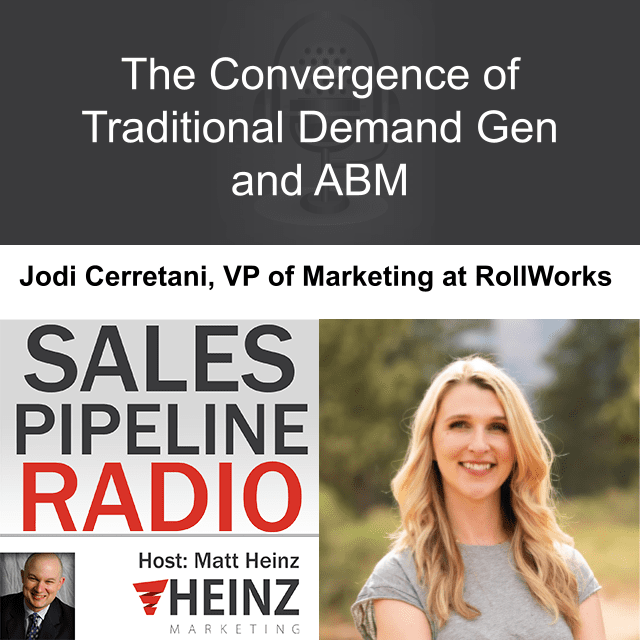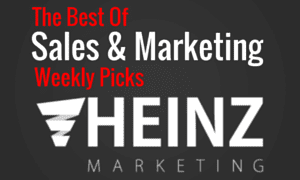Sales Pipeline Radio, Episode 339: Q & A with Jodi Cerretani

By Sheena McKinney, Sales Pipeline Radio Producer
If you’re not already subscribed to Sales Pipeline Radio or listening live every Thursday at 11:30 a.m Pacific on LinkedIn (also on demand) you can find the transcription and recording here on the blog every Monday morning. The show is less than 30 minutes, fast-paced and full of actionable advice, best practices and more for B2B sales & marketing professionals.
We cover a wide range of topics, with a focus on sales development and inside sales priorities. You can subscribe right at Sales Pipeline Radio and/or listen to full recordings of past shows everywhere you listen to podcasts! Spotify, iTunes, Blubrry, Google Play, iHeartRADIO, Stitcher and now on Amazon music. You can even ask Siri, Alexa and Google or search on Audible!
This week’s show is entitled, “The Convergence of Traditional Demand Gen and ABM“. My guest is Jodi Cerretani, VP of Marketing at RollWorks
Tune in to hear more about:
- How has the role of B2B marketing evolved in the past five years, and what impact does it have on business value and the P&L?
- What are the key elements to consider when prioritizing in-market signals for effective demand generation, and how can marketers leverage de-anonymized people, marketing qualified accounts, and intent qualified accounts?
- What is meant by “you can’t eat leads for dinner”?
Watch the video, listen in below and/or read the transcript below.
Matt: Welcome everybody to another episode of Sales Pipeline Radio. My name is Matt Heinz. Super excited to have y’all here. If you are joining us in the middle of your workday live, I’m so excited that you are here joining us live. You have the opportunity to be part of the show if you’re here live.
If you are watching on demand or listening on demand. Thank you so much for downloading, for subscribing.
We are on episode, I think 340 or so on this Sales Pipeline Radio journey over the last several years. And if you’re just catching up and just catching in, every episode of Sales Pipeline Radio from all the way back to the beginning is available at www.Salespipelineradio.com. Each week we’re featuring some of the best and brightest minds in B2B sales and marketing as this continues to evolve.
Very excited to have with us today Jodi Cerretani she’s the VP of Marketing at RollWorks. Jodi, we’ve known each other a long time. We can talk about the evolution of marketing. We can talk about the evolution of our children. And just evolution of our lives as all these things go as well. Welcome and thanks so much for being here.
Jodi: Oh, it’s my pleasure. Yeah, I’ve been keeping up with all your episodes so it feels full circle to be here speaking with you, and I’m excited to chat.
Matt: Well we talked about a bunch of different things we could cover today and I think the evolution of the B2B marketing role is kind of where I wanted to dig in. I’ve known you for a long time. We’ve both been doing this for a while. I don’t wanna say pre ABM days, right? But I remember when that wasn’t an acronym that anyone talked about. And now we’ve got ABM, we’ve got ABMX, or whatever they are now. The job hasn’t really changed, like the opportunity hasn’t changed, I think the tools and all the awareness of what marketing can do to support revenue objectives and business objectives is a little more at hand, but I’m curious to hear both in your role at RollWorks as well as in your career where you’ve seen that evolution work and, where you think people should be thinking about relative to it.
Jodi: Well, I actually feel like the requirements of the head of marketing has changed pretty significantly in the last, I don’t know, call it five years. It used to be that a lot of folks in my role, the requirement was that they were a storyteller first. Perhaps they grew up in product marketing or corporate marketing and they hired a really strong, number two in their demand gen function, at least in the last 15 years, who was an operator, a numbers native, and that kind of thing. And together they would have the whole suite. But now I see it as the requirements may be changing, and of course it varies by stage of company and all of that, but especially in the last couple of years where you really need to survive, if not to thrive, to understand deeply how every action that you take, every investment that you make, whether that’s your people investments or your, or your dollar investments, how that’s gonna translate into business value and how that’s gonna impact basically the P & L.
There has been a shift to some degree of the requirements and where folks really need to go deep versus where they can partner with other members of their team to do some stuff and so that seems to be changing, at least a lot of the conversations that I’ve been having.
I’m lucky enough to speak to a lot of customers and prospects, and it seems like those that are winning and definitely have a different mix to their skillset for whatever that’s worth.
Matt: Yeah. I think that’s absolutely right, and I think that if you get marketing leaders who think beyond just my job is to generate leads and to think my job is not just to generate pipeline. My job is to generate business impact. Right? And so, you start to have marketing leaders that think about, not just pipeline, think about customer led growth. Think about the impact that brand can have on driving demand, right? And creating what I think can be a better balance and getting away from what really have always been just sort of random acts of marketing, right? Sort of these siloed “campaigns” because they’re really just tactics. They’re sends. I’m thinking now about a real campaign, a real body of work across multiple channels across time that has a bigger short-term and long-term impact on the business.
Jodi: Yeah, absolutely. And it feels like that everything, fundamentally is about trade-offs. Every time that you’re focused on one thing, it’s almost by definition an opportunity cost for something else that you could be investing in with, people or minutes in the day.
But in terms of ABM and how things have changed, I think honestly, Matt, we’ve been doing this so long that we know that there is some amount of predictability in how a lot of vendors or thought leaders, they start to kind of reject a system at a certain point, and conveniently they introduce a new system that is sort of the antithesis of the last system, right?
We’ve seen that with outbound versus inbound. We’ve seen that with the form and the MQL. Is it dead? Is it not dead? It’s interesting if you kind of double tap on the folks that are really vocal about things being dead and new things being the new way, they’ve got something to gain typically.
And I think that the reality is, and you’ve said this before and I think it’s brilliant– marketers tend to be dichotomous thinkers, but we really have to encourage ourselves not to think black and white. It doesn’t always have to be an either or. In fact, outbound is not dead and people are still using forms and MQLs are still quite popular among B2B marketers.
And so I think thinking more about a blend can really, I think add some focus and clarity to your organization and not get so caught up in hype cycles. Right?
Matt: I’m so glad to hear you say that. We’re talking today on Sales Pipeline Radio with Jodi Cerretani. She’s the VP of marketing at RollWorks. We’ve gone from account led to product led to event led to people led, and it’s not one or the other. It’s kind of yes to most of these, or many of these, I guess depending on who your audience is, how you go to market. I think we as. Not just we as marketers, like we as humans, want the world to be easier.
We want the systems to be simpler, right? And it’s not, right? I mean, I think we fool ourselves that it used to be easy and effective. When we would send an email out, generate a white paper lead, send it to a 23-year-old to get some pipeline, I would argue that that actually never worked. Because there’s always been a buying committee.
There’s always been this need for a body of work and really investing in brand and credibility before you get somewhere. And so to me this the idea of thinking about an account based model. I think we’re kind of in this post ABM world where most companies in B2B need to be taking an account-based approach and then thinking broadly about the jobs to be done within that.
You’re talking to a lot of companies that are doing this. What are you seeing? And what are some of the themes you see that are making some of those go to Market Motion Successful?
Jodi: Well, I think that there’s some core tenants of an account-based approach that have always been good practices, but now I think it’s becoming more and more the standard.
You can call it ABM, you can call it, you know, sales focused marketing or whatever. I mean, honestly, I think if you’re really good at your job, you’ve probably been doing ABM longer than ABM was ABM. And the requirement is, is that you are fit focused, right. The requirement is, is you’re taking a surgical or precise approach to how you are going after and trying to drive results. Right? And it also [00:07:00] requires that you’re very much aligned to business outcomes and the rest of the go-to-market organization. Definitely SDR and sales, but in, in a lot of organizations increasingly to the CX side of the organization as well.
So if those core tenants are in place, I think one could argue that you are practicing an account-based approach, or maybe it’s just demand gen in a post ABM world like you talked about. I’ve noticed that people are starting to really understand that when these two things aren’t by definition, separate, totally separate, that demand gen can really benefit from the precision of an account based approach.
And conversely, ABM as it’s typically thought of, can really benefit from the scale of traditional demand gen channels, technologies, practices. So I think like I said before, if we are thinking less about siloed teams, siloed practices, entirely different motions between account based marketing and ABM, it really unlocks a whole lot of everything, right? Because you can have that scale and that volume that we all are desperate for right now with very high conversion rates, high velocity, high average deal sizes, et cetera.
Matt: So we got a question from across the pond, Ross in the UK wants to know all these different data sources, all these different potential platforms and channels to use with ABM, how do you prioritize stack rank the right tactics to get real business results? And I realize that is a very big question and probably is a different answer for different companies. Is there a framework or a set of questions that you typically go through with clients to say like, “here’s how to land the plane. Here’s how to think about the tactics and the sequences that make the most sense”
Jodi: Love this question, Ross. Thanks for asking it. I always say that there’s kind of two sides of demand generation, right? There’s, there’s revealing demand or, capturing demand. And there is true demand creation.
So I would always start with identifying what demand already exists, and that really lives in your data sources or in what we, we like to call signal sources. You’re wanting to look for data that can tell you who is in market, whether that’s a person or an account, right? Especially right now in this environment, when there’s arguably fewer buyers that are gonna be in market, they’re out there but we can’t necessarily wait until they raise their hand and request a demo or become an MQL.
I would really recommend, and this is really to everyone, regardless of their business, they get their data house in order to prioritize illuminating in market signals.. At RollWorks we like to think of, obviously conversions, leads and MQLS but also de anonymized people. There’s now new technology that you can actually de anonymize site traffic and add engagers as a whole new source of demand, and you don’t have to have those dreaded unknown site visitors or unknown ad clickers that you can’t do anything with. Now that’s possible. Right? And, and then also marketing qualified accounts and intent qualified accounts when you’re leveraging first and third party data.
So, I don’t know if I would say that I have exactly the right, vendor. Obviously I have a bias here because RollWorks provide some of some of this data. But I would say regardless of what tool stack you’re looking at, Get really, really laser focused on quickly actioning in mark signals on the person in the account level to make sure that you’re never letting a buyer go by and, you don’t have those buyer blinders on.
After you nailed that bit, then you could talk about what is the data that I’m going to leverage to then create demand. At a certain point that will run out, your existing demand will run out, so you’ll need to create more demand and that’s sort of a second phase that’s important to invest in.
Matt: I think it’s great advice. And Ross, I just add that I think forever marketers have prioritized prospect action. And I think the real opportunity here is to really to go after prospect intent. You don’t have to wait for someone to come to your website. You don’t have to wait for them to download your white paper.
Just cuz they came to your last three webinars doesn’t mean they’re qualified. It might be mean that they’re bored. Right. And so that doesn’t imply. They’re actively ready for a 20-minute demo letter on what you’re selling. So if you understand your audience well enough and are watching for, and, activating the intent signals that exist and activating that across not just your marketing efforts, but your sales and BD and customer teams as well, that’s where you start to win and I think as we got a few more minutes with you here, This question of change management comes up every time we talk about account-based motions and companies. This is not a campaign, this is a culture change in most companies in terms of how they go to market, how they integrate their teams, the data, everything together.
What are the best practices you’ve found to get the broader go-to market teams, sales, marketing, customer success to really work in concert to make an account-based motion successful?
Jodi: There’s the standard stuff that folks talk about. Hire the right people, put the right processes in place, have the right tools to support, looking at the same data and taking action, in cooperation with one another and I don’t think I’m gonna say anything too revolutionary there. You need to do all those things, right? If, you’ve got the wrong folks that have bad taste in their mouth when it comes to these different individuals or aren’t sort of bought into the fact that they’re one team, probably you’re gonna fail, you know, and, and along the road that, that lots of folks talk about.
I would say that for me, if I’m just getting really real with you, I actually put the, a lot of the alignment issue. I, say if you’re a, a marketing lead, it’s the, the onus is on you in many ways. Right. Cuz we can’t eat leads for dinner, right? We eat revenue. So the revenue teams are really, we’re all at the service of revenue you know, arguably on the go to market side.
So I think it’s up to us as, as marketers to really prove the value that we bring, and I use that word prove deliberately because I think that one of the things that folks really goof up when they’re trying to get alignment is they put together a really pretty PowerPoint presentation. They got that meeting, they got the right folks in the room. Right? And they show, here’s what I’m gonna do and here’s how it’s all gonna work. My understanding of a revenue focused sales and CX leaders, and really the C-suite is, is PowerPoint presentations don’t do anything.
It actually might work against you. So I would recommend running a pilot on an account based approach. They would typically will share with you who their top tier accounts are, sales folks and AMs and CSMs by definition or account based, right? And so they have their hot list of who they’re trying to convert or retain, get that list of, of accounts and show what you can do, right?
Run some programming, and then deliver the results in that PowerPoint presentation. I promise you the buy-in will be there at least initially, and then you can show them what the plan is, the go forward plan. I would also say that there’s a lot that goes into credibility.
And so a lot of times, you know, marketing, we’re in a super protected space, right? We’re, sitting behind our computers or what have you, but your frontline folks, they’re in it, they’re in the hot seat. It’s tough. So I would also say that if if you haven’t made this a part of your practice to sit on sales calls, to be in renewal conversations to cold call yourself.
And that’s gonna earn you a ton of credibility that you know the pain that they are often in when they’re asked difficult questions or they have a cold lead or not the right person. I mean, it’s tough man. And I think that it really, really focuses the marketing team, everyone in the marketing team to be thinking about the right stuff.
And at the same time, it really establishes that, that one team, I’m almost reminded of, you know, my stepfather was in the military. He talks so much about being in the trenches and folks that were, you know, maybe in the office, in the military, they don’t have the same street cred as, as the folks in the trenches. And I think the same idea applies, if you’re not in that “with them” feeling the burn, showing up, showing face, answering questions, you know, all of that. I, think it’s gonna be tough for them to really see you as part of their organization. So that’s another small but meaningful tip is, get in there with them. And, to summarize, it’s, get in there with them, and prove it.
Matt: If you are listening to us on demand, go rewind six minutes and listen to that again. Cause that was really, really good. Here’s a few things that I heard and summarize out of that.
First is you can’t eat leads for dinner. That is going on the highlight reel for sure. Look, this is not your grandma’s marketing. This is more complex. This is more nuanced. There’s more tech involved, there’s more integration involved. So there’s a need to embrace the complexity, but to do it together, to make this a team sport, to do this and know that it’s gonna be hard to know that there’s gonna be complexity as part of the process.
But if you’re all in it together in the trenches, in the weeds, whatever you wanna call it that’s what’s gonna win. And you’re gonna win as a team to find something that you actually can eat for dinner. How’d I do?
Jodi: Yeah. Love that.
Matt: Awesome. Well, we’re out of time. Jodi Cerretani, VP of Marketing for RollWorks.
Thank you so much. It’s great to see you. I think it’s cause we have kids that we’re prioritizing at home we don’t see each other on the road as much anymore, but great to see you and get some time to catch up.
Jodi: Yeah, likewise. Thanks for having me.
Matt: Thank you everyone for joining us. We’ll be back here next week every Thursday, 11:30 Pacific, 2:30 Eastern. Until then we’ll see you next time on Sales Pipeline Radio.
Take care.
Listen to the Latest Episodes:
Matt interviews the best and brightest minds in sales and Marketing. If you would like to be a guest on Sales Pipeline Radio send an email to Sheena@heinzmarketing.com.






